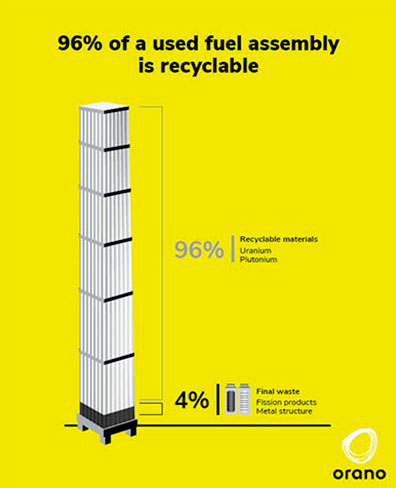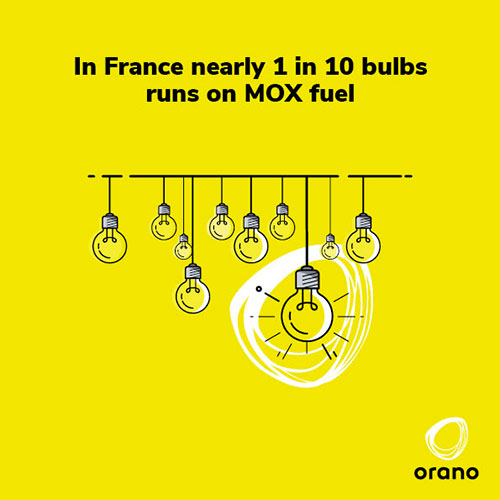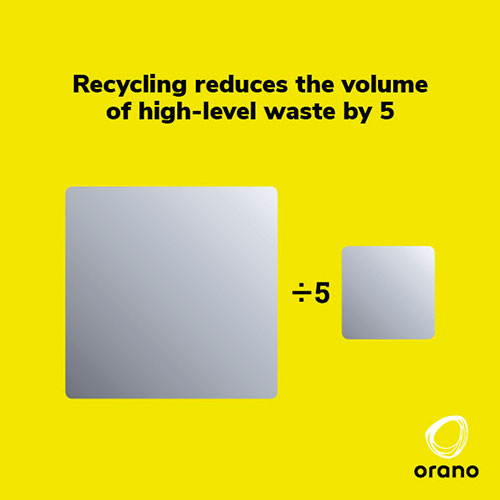
Everything you need to know about France's National plan for the management of radioactive materials and waste
From April 17 to September 25, 2019, the National Public Debate Commission (Commission nationale du débat public – CNDP) is organizing a public debate in order to prepare for the 5th National Plan for the Management of Radioactive Materials and Waste (Plan National de Gestion des Matières et Déchets Radioactifs – PNGMDR) for 2019-2021. Updated every three years, the PNGMDR is a document that assesses existing methods of managing radioactive waste and materials, identifies foreseeable storage and disposal facility requirements and indicates the capacities needed for those facilities and the duration of storage.

Orano welcomes the launch of this public debate, the first to be held as part of the revision of the PNGMDR. It is an opportunity to explain the main issues regarding radioactive waste and materials, and respond to any questions or concerns raised. It is also an opportunity to remind people that nuclear waste is inventoried, monitored, conditioned and disposed of in centers intended for this purpose, or safely placed in interim storage pending a definitive solution.
What is radioactive waste?
Some radioactive substances are classified as materials while others fall into the category of waste.- A radioactive material is a substance for which subsequent use, after processing if necessary, is specified or planned. It may thus be recovered, recycled and reused. It is mainly new or used nuclear fuels, made from (natural, enriched, depleted or reprocessed) uranium, or from plutonium, that fall into this category.
- Radioactive waste consists of radioactive substances for which no further use is foreseen or planned, or which have been requalified as such by the administrative authority.
See our "Unpacking nuclear" report: "All about radioactive waste un France"

The French Environmental Code entrusts the French National Agency for Radioactive Waste Management (Agence nationale pour la gestion des déchets radioactifs – Andra) with the task of drawing up a national inventory of radioactive materials and waste every three years. It is available on the Andra website. This inventory is used as input data for preparation of the PNGMDR. There is also a classification of radioactive waste.
Recycling: a sustainable solution for the nuclear industry
Thanks to Orano's world-leading technologies in processing and recycling, almost 96% of the used fuel from nuclear power reactors and research reactors can be recycled. Nuclear material can be reused to make new fuels that will in turn generate their own electricity.Another advantage of recycling: savings on raw materials. One gram of plutonium, 100 grams of uranium or 300 grams of depleted uranium have the same energy potential as 1 metric ton of crude oil, 2.5 metric tons of wood or 1.5 metric tons of coal.
10% of French nuclear electricity currently comes from recycled materials. With the steps forward being made in industrial terms, and in particular the use of recycled MOX fuel in new (1,300 MW) reactors or the multi-recycling of nuclear fuels, this ratio could be increased to as much as 30%.

Another major advantage of recycling is that it reduces the volume of final waste (4% of used fuel) by a factor of 5 and its radiotoxicity by a factor of 10 in its long-term radioactivity. This high-level waste is then conditioned in a safe and sustainable way. It is encapsulated in a molten glass allowing the radioactivity of waste to be contained over the very long term (more than 100,000 years) and put into interim storage on the la Hague site. According to the French Nuclear Safety Authority (ASN), when combined with geological disposal, vitrification is the safest solution.

Depleted uranium, a strategic reserve
In addition to the materials contained in used nuclear fuels (after use in nuclear reactors), depleted uranium, obtained via the process of enrichment of natural uranium (prior to use in nuclear reactors) is also a recyclable material. It can be used to produce low-carbon electricity. Beyond its current means of recycling in Mox fuel, other prospects for recovery include re-enriching it to obtain ENU (enriched natural uranium) fuel which can be used in existing reactors. Depleted uranium may also be able to be reused in fourth-generation reactors.Today, it constitutes a strategic reserve which may be considered to a "domestic mining resource" (300,000 metric tons): a major asset for France. This volume corresponds to around 60,000 metric tons of natural uranium, or around 7 to 8 years of annual consumption of uranium for the existing French nuclear fleet.
Disposal of high-level waste: the CIGEO solution
Andra is responsible for managing existing disposal centers and conducting studies on geological disposal for high-level and long-lived intermediate-level waste. CIGEO, located at Bure-Saudron (Meuse/Haute-Marne - France), is a geological disposal project. It represents the most sustainable and safest solution for assuming our responsibility to future generations with regard to final waste which is currently in safe interim storage in facilities on the la Hague site.
Management of very low-level waste (VLLW)
This is one of the issues at stake for the PNGMDR. Currently, in France, any product that has entered a nuclear zone is considered to be radioactive – regardless of its actual level of radioactivity.In the rest of Europe, waste is qualified on the basis of its radioactivity: below a certain radioactivity threshold, waste is no longer considered to be radioactive.
With a strong demand in society to develop the circular economy, the recycling of very low-level metal waste could for example be envisaged. This new approach, implemented taking all the necessary precautions, would not only allow savings to be made on raw materials but also enable the volume of waste for disposal to be reduced.
Example 150,000 metric tons of metal from the dismantling of diffusers from the old Georges Besse 1 enrichment plant, which was shut down in June 2012, are VLL materials that can be reused.
- Nuclear waste Managing radioactive and nuclear waste is a duty of responsibility towards future generations and an area where Orano has cutting-edge expertise.
- All about radioactive waste in France Managing radioactive and nuclear waste is a duty of responsibility towards future generations and an area where Orano has cutting-edge expertise.
- Recycling: a strategic asset for the nuclear industry Thanks to Orano’s unique technologies, 96% of used nuclear fuel is recycled. For more than 50 years, at its La Hague and Melox plants, the group has been processing recoverable materials and fabricating new MOX fuels.